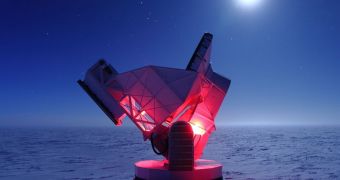During the Reionization Epoch, a time in the early history of the Universe when hydrogen gas was being ionized, the first massive galaxies sprung into existence. New data suggest that the process took place explosively fast, and that the structures disappeared a lot sooner than they should have had.
Using data from the South Pole Telescope (SPT) and other observatories, an international team of astronomers, coordinated by researchers at the University of California in Berkeley (UCB), found that massive galaxies developed sooner than first thought, and disappeared faster, too.
These objects started illuminating the Universe just 750 million years after the Big Bang. This is very fast, considering that the first stars developed around 300 million years after the firmament appeared.
The age of the Cosmos is estimated at 13.75 billion years, which means that, nearly 13 billion years ago, massive galaxies already existed. Since that time, they may have disappeared, or may have become the seeds of massive galactic superclusters or galactic walls.
“We find that the [Reionization Epoch] lasted less than 500 million years and began when the Universe was at least 250 million years old. Before this measurement, scientists believed that reionization lasted 750 million years or longer, and had no evidence as to when reionization began,” Oliver Zahn explains.
During this age, the light and radiations produced by the first stars contributed to creating huge ionization bubbles in the surrounding hydrogen gas. In addition to enabling the formation of even more stars, the process also left behind marks in the Cosmic Microwave Background (CMB).
Zahn, the leader of the SPT data analysis team, holds an appointment with the UCB Berkeley center for Cosmological Physics (BCCP). Details of the new investigation were published in the September 1 print issue of the esteemed Astrophysical Journal.
“Studying the [Reionization Epoch] is important because it represents one of the few ways by which we can study the first stars and galaxies,” University of Chicago expert and study coauthor, John Carlstrom, explains.
Future SPT upgrades will enable astronomers to establish when the Reionization Epoch began and ended within an accuracy level of 50 million years. Proportionally speaking, this is a tremendous feat.

 14 DAY TRIAL //
14 DAY TRIAL //